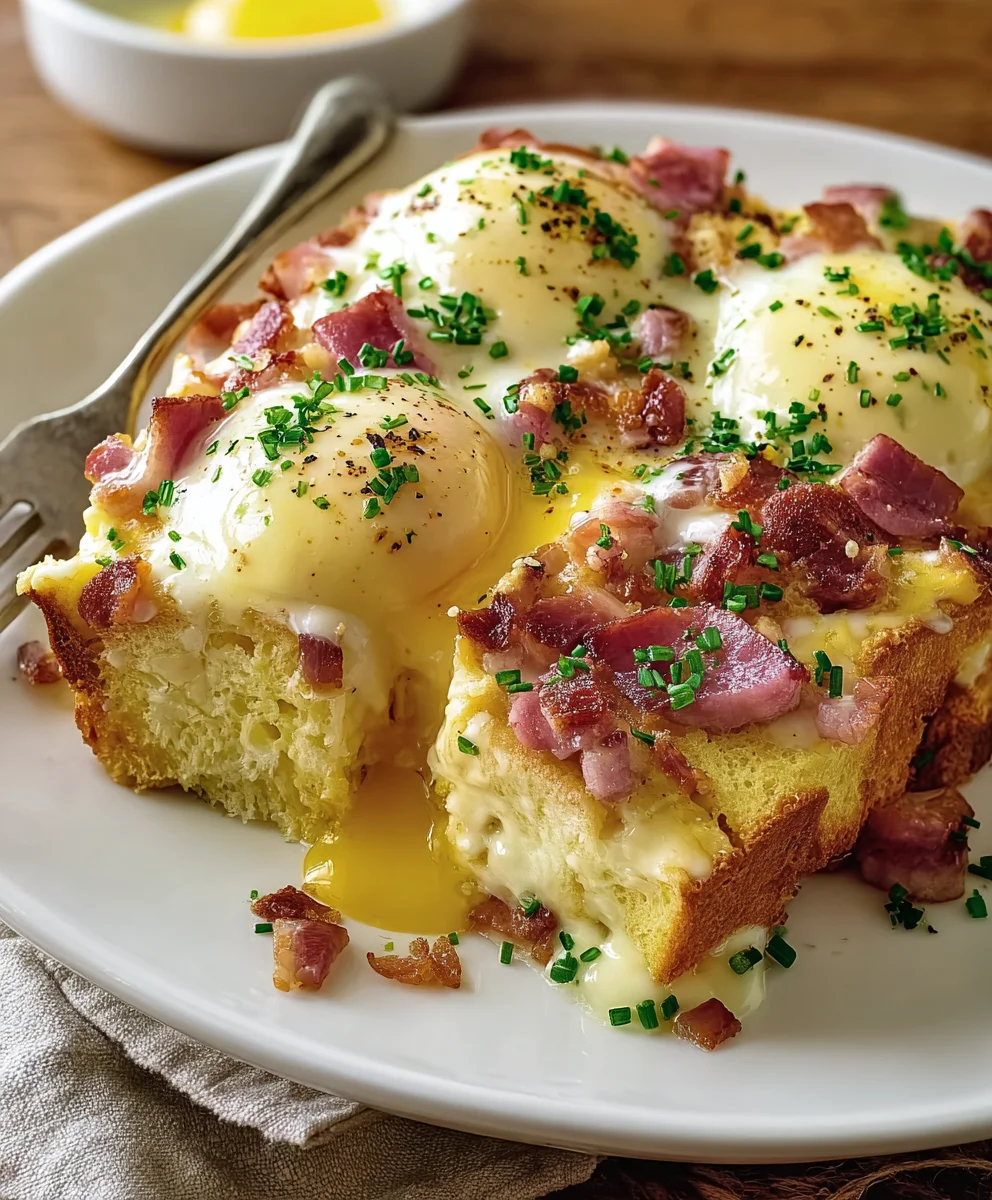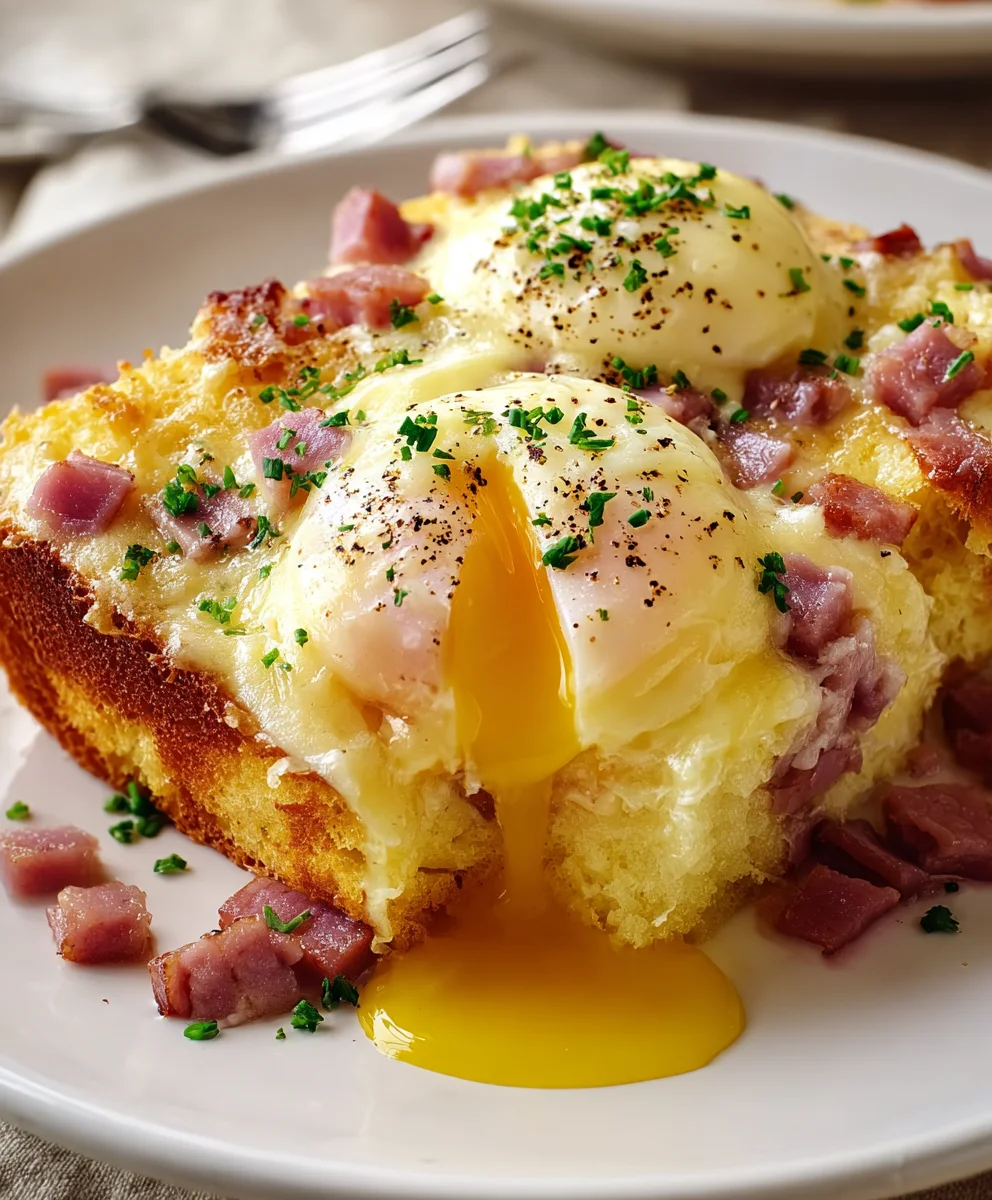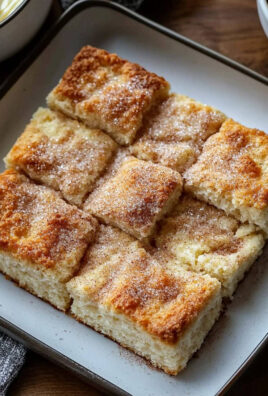Eggs Benedict Casserole is nothing short of a culinary revelation, transforming a beloved, yet often labor-intensive, brunch classic into an effortlessly elegant dish perfect for feeding a crowd.
Have you ever dreamt of savoring the iconic flavors of perfectly poached eggs, savory Canadian bacon, and luscious hollandaise sauce without the stress of individual preparations?
While the traditional Eggs Benedict boasts a rich history, with fascinating origins debated between the Waldorf Astoria and Delmonico’s in 19th-century New York, its complexity often limits it to intimate gatherings or restaurant visits.
But fear not, brunch enthusiasts! This magnificent Eggs Benedict Casserole takes all the elements we adore – the tender English muffins, the salty ham, the custardy eggs, and that irresistible, buttery hollandaise – and bakes them into a single, cohesive, and utterly delicious creation. I adore this recipe because it offers unparalleled convenience without compromising on flavor or that luxurious brunch experience. It’s the ideal solution for weekend entertaining, allowing you to spend more time with your loved ones and less time in the kitchen.

Ingredients:
- For the Casserole Base:
- 6-8 cups (approximately 1 lb) stale or day-old sourdough, challah, or brioche bread, cut into 1-inch cubes. I find that slightly stale bread absorbs the egg mixture beautifully without becoming soggy.
- 12 ounces Canadian bacon or ham, thinly sliced or diced into ½-inch pieces. Canadian bacon is my preferred choice for that classic Eggs Benedict flavor, but good quality ham works wonderfully too.
- 1 cup (4 ounces) shredded Gruyère cheese, divided. Gruyère adds a nutty, savory depth that I absolutely adore, but Swiss or even a sharp white cheddar can be substituted.
- ½ cup chopped fresh chives, divided, plus more for garnish. These add a lovely mild oniony freshness.
- 2 tablespoons unsalted butter, for sautéing.
- For the Egg Custard:
- 12 large eggs. Fresh, large eggs are key for a rich custard.
- 2 cups whole milk. Whole milk provides the best richness, but 2% will also work.
- ½ cup heavy cream. This is my secret to an extra luscious, creamy custard. Don’t skip it if you want that luxurious texture!
- 1 teaspoon Dijon mustard. A tiny bit of Dijon really brightens the flavor of the egg mixture.
- ½ teaspoon salt.
- ¼ teaspoon black pepper.
- Pinch of cayenne pepper (optional, but I love the subtle warmth).
- For the Easy Hollandaise Sauce (Homemade or store-bought):
- 10 tablespoons unsalted butter. Good quality butter makes a huge difference here.
- 3 large egg yolks. Separate carefully to avoid any white.
- 2 tablespoons fresh lemon juice. Freshly squeezed is non-negotiable for the best flavor.
- ½ teaspoon Dijon mustard. Again, a little Dijon boosts the flavor and helps stabilize the emulsion.
- ¼ teaspoon salt.
- Pinch of cayenne pepper. Adds a lovely subtle heat without being spicy.
Preparing the Casserole Base
- Prepare the Bread: If your bread isn’t already stale, you can lightly toast the cubes on a baking sheet in a 300°F (150°C) oven for 10-15 minutes, or until just dried out. This step is crucial because it prevents the bread from turning mushy once it absorbs the egg mixture. You want it firm enough to hold its shape, but still capable of soaking up all that eggy goodness.
- Sauté the Canadian Bacon: In a large skillet, melt 2 tablespoons of unsalted butter over medium heat. Add the diced Canadian bacon (or ham) and cook for 5-7 minutes, stirring occasionally, until it’s lightly browned and slightly crispy at the edges. I like to render it slightly to bring out its savory depth and prevent it from being too chewy in the finished casserole. Once cooked, transfer the bacon to a plate lined with paper towels to drain any excess fat.
- Assemble the First Layer: Lightly grease a 9×13 inch baking dish. Spread half of the prepared bread cubes evenly over the bottom of the dish. I find it helpful to make sure there are no large gaps, so the casserole bakes uniformly.
- Layer the Fillings: Sprinkle half of the cooked Canadian bacon over the bread layer. Then, evenly distribute half of the shredded Gruyère cheese (½ cup) and half of the chopped fresh chives (¼ cup) over the bacon. This layering technique ensures that every bite of your Eggs Benedict Casserole will have a delightful mix of flavors and textures.
- Repeat Layers: Place the remaining bread cubes on top of the first layer of fillings. Follow with the rest of the Canadian bacon, the remaining Gruyère cheese (the second ½ cup), and the remaining chopped chives (the second ¼ cup). Take a moment to admire your beautifully layered casserole – it’s already looking impressive!
Preparing the Egg Custard
- Whisk the Wet Ingredients: In a large bowl, crack the 12 large eggs. Add the 2 cups of whole milk and ½ cup of heavy cream. This combination provides the perfect balance of richness and moisture for a custardy texture.
- Season the Custard: Incorporate 1 teaspoon of Dijon mustard, ½ teaspoon of salt, ¼ teaspoon of black pepper, and a pinch of cayenne pepper (if using). The Dijon adds a subtle tang that complements the savory ingredients beautifully, and the cayenne just gives it a tiny, pleasant warmth without making it spicy.
- Combine Thoroughly: Whisk everything together vigorously until the eggs are completely broken up, and the mixture is well combined and slightly frothy. You want to make sure there are no streaks of egg white remaining, as this will ensure a smooth, even custard throughout your Eggs Benedict Casserole.
- Soak the Casserole: Carefully pour the rich egg mixture evenly over the layered bread and bacon in the baking dish. Make sure every piece of bread gets a good soak; this is crucial for a custardy, tender casserole rather than a dry one. Gently press down on the bread with the back of a spoon or a spatula to ensure it’s fully submerged and absorbing the liquid.
- Chill for Flavor Development: Cover the baking dish tightly with plastic wrap. Refrigerate the casserole for at least 4 hours, or preferably overnight (up to 24 hours). This chilling period is essential! It allows the bread to fully absorb the egg mixture, which contributes to a superior texture and ensures that the flavors meld together beautifully. Trust me, patience pays off for a truly exceptional Eggs Benedict Casserole.
Baking the Eggs Benedict Casserole
- Preheat Oven and Prepare for Baking: When you’re ready to bake, remove the casserole from the refrigerator at least 30 minutes before baking to allow it to come closer to room temperature. This helps with more even baking. Preheat your oven to 350°F (175°C).
- Cover and Bake: Remove the plastic wrap and cover the baking dish loosely with aluminum foil. Baking it covered for the initial period helps the casserole cook through without the top browning too quickly.
- Initial Bake Time: Bake for 40 minutes with the foil on. During this time, the custard will begin to set, and the flavors will continue to develop.
- Uncover and Finish Baking: Remove the foil and continue baking for another 25-35 minutes, or until the casserole is golden brown on top, puffed up, and a knife inserted into the center comes out mostly clean. The internal temperature should reach 160°F (71°C). I always look for that beautiful golden crust and a satisfying jiggle when I gently shake the dish – it tells me it’s almost perfect.
- Rest Before Serving: Once baked, remove the Eggs Benedict Casserole from the oven and let it rest for 10-15 minutes before serving. This resting period is important because it allows the custard to fully set and makes for cleaner slices. It also prevents it from deflating too much, ensuring a lovely presentation.
Preparing the Easy Hollandaise Sauce
While the casserole is resting, prepare your glorious Hollandaise sauce. This truly elevates the dish from a great breakfast bake to an incredible Eggs Benedict Casserole experience.
- Prepare a Double Boiler (Bain-Marie): Fill a medium saucepan with about an inch or two of water and bring it to a gentle simmer over medium-low heat. You don’t want a rolling boil, just enough steam to heat your bowl.
- Melt the Butter: In a separate small saucepan, melt the 10 tablespoons of unsalted butter over medium-low heat. Once melted, keep it warm but not hot enough to brown. Some recipes call for clarified butter, but for this “easy” version, I find just melted butter works perfectly well and saves a step.
- Combine Egg Yolks and Flavorings: In a heatproof bowl (preferably a stainless steel or glass bowl that fits snugly over your saucepan without touching the water), combine the 3 egg yolks, 2 tablespoons of fresh lemon juice, ½ teaspoon of Dijon mustard, ¼ teaspoon of salt, and a pinch of cayenne pepper. Whisk these ingredients together until they are lightened in color and slightly thickened – this usually takes about 30 seconds to a minute of vigorous whisking.
- Cook the Egg Yolk Mixture: Place the bowl over the simmering water, making sure the bottom of the bowl does not touch the water. Continue to whisk vigorously and constantly. The mixture will gradually thicken and become pale yellow and foamy. This process, called tempering, should take about 3-5 minutes. You’re looking for it to coat the back of a spoon. Be very careful not to overheat the eggs, or they will scramble! If it feels like it’s getting too hot, lift the bowl off the heat for a few seconds while continuing to whisk.
- Emulsify with Butter: Once the egg mixture is thick and foamy, slowly begin to drizzle in the warm melted butter, a tablespoon at a time, while continuing to whisk vigorously. The key here is a very slow, steady drizzle while whisking continuously and vigorously. This constant motion is what creates the stable emulsion. If you pour too quickly, your sauce will likely break and separate. Take your time, especially at the beginning.
- Continue Drizzling: As the sauce starts to thicken and emulsify, you can slightly increase the rate of your butter drizzle, but still maintain that continuous whisking. Keep whisking until all the butter has been incorporated and you have a thick, smooth, and glossy Hollandaise sauce. If the sauce becomes too thick, you can whisk in a teaspoon or two of hot water to thin it to your desired consistency.
- Adjust Seasoning: Taste the Hollandaise and adjust the salt or lemon juice if needed. Sometimes I like a little extra lemon zest grated in for an extra pop of freshness. Serve immediately.
Serving the Eggs Benedict Casserole
- Slice and Serve: Once the Eggs Benedict Casserole has rested, use a sharp knife to cut it into individual squares or portions.
- Garnish and Enjoy: Transfer each slice to a plate. Generously spoon the warm, velvety Hollandaise sauce over each portion. Finish with an extra sprinkle of fresh chives for garnish. I sometimes like to add a dash of paprika for color, too. Serve warm and watch your family or guests devour this comforting and elegant brunch dish.
- Optional Accompaniments: This casserole is hearty enough to be a standalone meal, but it pairs wonderfully with a fresh green salad, some roasted asparagus, or a side of fresh fruit for a complete brunch experience.

Conclusion:
So, there you have it, my friends! We’ve journeyed through the simple steps to create what I truly believe is one of the most brilliant brunch innovations to grace our tables: the magnificent Eggs Benedict Casserole. If you’ve ever yearned for the luxurious taste of classic Eggs Benedict but shied away from the intricate dance of poaching eggs and emulsifying hollandaise at the last minute, then this recipe is your culinary salvation. It’s more than just a dish; it’s a promise of effortless elegance and guaranteed satisfaction, making it an absolute must-try for any home cook, from novice to seasoned pro.
What makes this Eggs Benedict Casserole truly exceptional? It’s the ingenious way it takes all the beloved components – the perfectly set eggs (achieved here through baked eggs nestled in a savory custard), the crisp Canadian bacon, the toasted English muffin base, and that unmistakable tangy, rich hollandaise – and bundles them into one gloriously easy-to-assemble, make-ahead dish. Imagine waking up on a lazy Sunday morning, pulling this beauty from the fridge, sliding it into the oven, and emerging with a golden-brown masterpiece that looks and tastes like you’ve spent hours in the kitchen. That, my dear readers, is the magic we’re talking about. It’s perfect for feeding a crowd without breaking a sweat, allowing you to actually enjoy your guests rather than being tethered to the stove, diligently poaching individual eggs.
Elevate Your Brunch Experience with These Serving Suggestions & Variations
While this casserole is a showstopper all on its own, a few thoughtful additions can transform your brunch spread into an unforgettable feast. For a classic pairing, I always recommend a fresh, vibrant fruit salad bursting with berries, melon, and citrus. A crisp green salad with a light vinaigrette can also offer a lovely counterpoint to the richness. And, of course, no brunch is complete without a steaming pot of coffee and perhaps some celebratory mimosas or sparkling cider. For those who love variety, consider these exciting twists:
- Protein Power-Up: While Canadian bacon is traditional, don’t hesitate to experiment! Try smoked salmon for a “lox and eggs” inspired casserole, crispy prosciutto, diced ham, crumbled breakfast sausage, or even thinly sliced, cooked steak for a heartier meal. For a fantastic vegetarian option, sautéed spinach, mushrooms, or asparagus spears make wonderful additions folded into the egg mixture.
- Cheese Please: A sprinkle of Gruyère or Swiss cheese mixed into the egg custard or layered on top adds another dimension of flavor and a beautiful golden crust. Sharp cheddar or Monterey Jack could also be deliciously decadent choices.
- Bread Base Bonanza: Instead of English muffins, consider using cubes of brioche or sourdough for a richer, chewier base. You could even use a layer of hash browns for a more rustic, potato-forward experience that’s equally satisfying.
- Hollandaise Hacks: If you’re feeling adventurous, infuse your hollandaise with a pinch of cayenne pepper for a subtle kick, or a squeeze of fresh lime juice for an extra bright note. A drizzle of sriracha mayo or a simple lemon-herb aioli could also be a fun, modern twist if you’re not a traditionalist.
- Veggies Galore: Feel free to fold in sautéed bell peppers, onions, sun-dried tomatoes, or blanched asparagus pieces into the egg mixture before baking for added nutrients, color, and texture.
The beauty of this recipe lies in its adaptability. It’s a canvas for your culinary creativity, inviting you to personalize it to your taste and what you have on hand. Whether you stick to the classic preparation or venture into exciting new variations, the core promise of deliciousness remains steadfast. I promise you’ll find joy in every bite!
Your Culinary Adventure Awaits!
I truly hope you’re feeling inspired to roll up your sleeves and give this incredible Eggs Benedict Casserole a try. I promise you, the joy of serving a dish this impressive with such minimal fuss is truly rewarding. It’s the perfect centerpiece for holiday brunches, weekend gatherings, or even just a luxurious start to a regular Tuesday (because why not treat yourself?). Don’t let the name intimidate you; the process is straightforward, and the results are consistently spectacular – a true triumph of make-ahead brunching.
Once you’ve experienced the magic of this dish, I would absolutely love to hear about it! Please, don’t be shy – come back and share your experiences in the comments below. Did you try a unique variation? Do you have any clever tips or tricks that made it even better for you? Your insights and stories are what make this community so wonderful and inspiring. Snap a photo of your masterpiece and share it on your favorite social media platforms, tagging me so I can celebrate your success! I can’t wait to see your incredible creations and hear how this recipe transforms your brunch game. Happy cooking!
Frequently Asked Questions (FAQs)
Can I make Eggs Benedict Casserole ahead of time?
Absolutely, and I highly recommend it! That’s one of the greatest advantages of this recipe. You can assemble the entire casserole, including the bread, Canadian bacon, and egg mixture, the night before. Cover it tightly with plastic wrap and refrigerate. When you’re ready to bake, just pull it out about 30 minutes before baking to let it come closer to room temperature, then bake as directed. Prepare the hollandaise fresh just before serving for the best results, or use a pre-made, high-quality sauce that simply needs warming.
What kind of bread is best for this casserole?
Traditional English muffins are my go-to for their classic texture and ability to soak up the egg custard beautifully without becoming soggy. However, you can certainly experiment! Cubes of brioche or sourdough bread will yield a richer, softer casserole. Some people even use challah or day-old croissants for a more decadent base. The key is to use bread that is slightly stale or toasted to prevent it from becoming mushy when it absorbs the liquid.
How do I prevent the casserole from being watery?
A watery casserole usually stems from either too much liquid in the egg mixture or ingredients releasing excess moisture. To prevent this, ensure your Canadian bacon (or other meat) is patted dry before adding. If using vegetables like spinach or mushrooms, sauté them first to release their water, then drain any excess liquid. Also, make sure your eggs are thoroughly beaten into the milk mixture, creating a uniform custard. Overbaking can sometimes dry out the edges and leave the center feeling watery, so keep an eye on it – it should be set and slightly puffed.
Can I freeze leftover Eggs Benedict Casserole?
You can! While I personally believe it’s best enjoyed fresh, especially with the hollandaise, individual portions of the baked casserole can be frozen. Allow the casserole to cool completely, then wrap individual slices tightly in plastic wrap and then in aluminum foil. They can be frozen for up to 1-2 months. To reheat, thaw overnight in the refrigerator, then warm in a preheated oven (around 350°F or 175°C) until heated through, covering with foil if needed to prevent over-browning. Be aware that the texture might be slightly softer after freezing and thawing.
What if I don’t like hollandaise sauce or want a different topping?
No problem at all! While hollandaise is classic, this casserole is delicious even without it. You could serve it with a simple drizzle of melted butter, a sprinkle of fresh chopped chives or parsley, or even a dollop of sour cream or Greek yogurt. For a cheesy twist, a quick cheese sauce (like a simple Mornay) or even just extra shredded cheese melted on top during the last few minutes of baking would be fantastic. A spicy sriracha mayo or a simple lemon-herb aioli could also add an exciting flavor profile!
How do I reheat Eggs Benedict Casserole?
To reheat individual slices or a smaller portion, the best method is usually in the oven. Preheat your oven to about 300-325°F (150-160°C). Place the casserole on a baking sheet, cover loosely with foil to prevent drying, and heat for 15-20 minutes, or until warmed through. You can also use a microwave for quicker reheating, but be mindful that the texture might become slightly rubbery, and the bread base won’t be as crisp. If reheating in the microwave, heat in 30-second intervals until hot.

Ultimate Eggs Benedict Casserole with Savory Beef
A culinary revelation, transforming a beloved, yet often labor-intensive, brunch classic into an effortlessly elegant dish perfect for feeding a crowd. This casserole takes all the elements we adore – tender English muffins, savory beef bacon, custardy eggs, and irresistible hollandaise – and bakes them into a single, cohesive, and utterly delicious creation.
Ingredients
-
1 pound beef bacon, diced
-
6 English muffins, split and cut into 1-inch pieces
-
8 large eggs
-
2 cups whole milk
-
½ teaspoon onion powder
-
½ teaspoon salt
-
¼ teaspoon garlic powder
-
¼ teaspoon black pepper
-
¼ teaspoon paprika
-
½ cup hollandaise sauce (store-bought or homemade)
-
3 teaspoons chopped fresh parsley, for garnish
Instructions
-
Step 1
Cut English muffins into 1-inch cubes. If not stale, lightly toast them at 300°F (150°C) for 10-15 minutes until dried. In a skillet, cook beef bacon until lightly browned and slightly crispy. Drain excess fat. -
Step 2
Lightly grease a 9×13 inch baking dish. Spread half of the English muffin cubes evenly over the bottom. Layer half of the cooked beef bacon over the bread. Repeat with the remaining English muffins and beef bacon. -
Step 3
In a large bowl, whisk 8 large eggs, 2 cups whole milk, ½ teaspoon onion powder, ½ teaspoon salt, ¼ teaspoon garlic powder, ¼ teaspoon black pepper, and ¼ teaspoon paprika until well combined and slightly frothy. -
Step 4
Carefully pour the egg mixture evenly over the layered ingredients in the baking dish. Gently press down to ensure all bread is submerged and absorbing the liquid. Cover tightly with plastic wrap and refrigerate for at least 4 hours, or preferably overnight (up to 24 hours). -
Step 5
Remove the casserole from the refrigerator at least 30 minutes before baking. Preheat oven to 350°F (175°C). Cover the baking dish loosely with aluminum foil and bake for 40 minutes. -
Step 6
Remove the foil and continue baking for another 25-35 minutes, or until the casserole is golden brown on top, puffed up, and a knife inserted into the center comes out mostly clean (internal temperature should reach 160°F / 71°C). -
Step 7
Remove from oven and let rest for 10-15 minutes before serving. Slice into individual portions. Generously spoon ½ cup warm hollandaise sauce over each portion and garnish with 3 teaspoons chopped fresh parsley. Serve warm.
Important Information
Nutrition Facts (Per Serving)
It is important to consider this information as approximate and not to use it as definitive health advice.
Allergy Information
Please check ingredients for potential allergens and consult a health professional if in doubt.





Leave a Comment